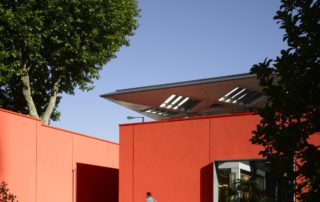Will Alsop enjoys Richard Rogers’ tale of his life in architecture

‘A Place for All People’
Richard Rogers
Canongate, 336pp, £30
‘A Place for All People’ is a good read about a remarkable life of work and pleasure, in which Richard Rogers ranges over eight decades, from his memories of childhood in Italy to his present-day reflections from London.
Lloyd’s of London trading floor (ph: Janet Gill, Nikki Trott)
The early life is important. Rogers was born in Florence a few years before the second world war into the ‘comfortable’ life of a doctor’s household, in a home filled with modernist furniture by his mother. She was from Trieste, a border port annexed by Italy after the collapse of the Austro-Hungarian Empire. For Italians in particular, the place where you are born defines you. They tend to talk with one another about their home towns while enjoying a glass placed on a checked tablecloth beneath a small vine. They transcend the ugliness of the immediate surroundings by creating a place, in a simple way, and talking about somewhere else. Rogers’ seems imbued with these qualities, which could help to explain how he has been able to overcome the apparent disadvantages of being both dyslexic and poor at drawing.
Lloyd’s of London (ph: Richard Bryant, Arcaid)
The war presented problems for a socialist-leaning family and after much debate it was decided to move to London (Rogers’ grandfather was English), escaping Mussolini’s fascism only to suffer the Blitz. Rogers’ father once wrily observed that to be truly English you had to be foreign. I think Rogers is indeed very English yet unable to escape his Italian background – a defining combination that explains much about him.
Lloyd’s of London, west-east section (drg: Rogers Stirk Harbour + Partners)
The book is illustrated not just with architectural projects, but with photos of parents, friends and collaborators, which helps gives the reader a much clearer insight into Rogers than earlier volumes. Above all it is clear that he dearly loves to be surrounded by children, grandchildren and close friends. The family is his citadel, his place of retreat, and his way of measuring the world.
Wimbledon House, 1968-70 (ph: Richard Bryant, Arcaid)
The book is an attempt to consolidate Rogers’ long and successful life into a clear message of intent and explanation. It seeks to look beyond the image of Mr High-Tech to what underpins his thinking and experiences. Of course memories are not always reliable, as over time we colour them to support our sense of well-being. Rogers refers to many buildings that have been influential for him, but the range is very diverse and I am left wondering whether it is more the overall poor quality of the built environment that has driven him to try to make life better.
Richard Rogers as a schoolboy at St John’s School (ph: Unknown, Rogers Stirk Harbour + Partners)
I found no reference to suburbia, which some might argue is an achievement of society and an expression of contentment. Rogers’ recollections of Florence, which I am sure are correct for him, don’t reflect the place as it is today. Visiting this great, historic city while reading the book, I found it sadly destroyed by mass tourism and no longer a pleasure. On the other hand, I wasn’t born there.
Zip-Up House, 1967-1969, by Richard + Su Rogers (drg: Rogers Stirk Harbour + Partners)
The book evokes a particular nostalgia for me. It includes Rogers’ unbuilt Coin Street proposal from 1978, a grand galleria of mixed-use buildings that arced around London’s South Bank to culminate in a pedestrian bridge across the Thames. It would have transformed Waterloo and its links to the city, but the public said ‘No’, as indeed it has recently said ‘No’ to the Garden Bridge. Rogers advocates that teamwork – in which he includes the public – is an important part of his practice. But sometimes the public is wrong.
Richard Rogers’ works are both wonderful and inspiring, and they represent a huge contribution to architecture in the twentieth and early twenty-first centuries. I hope there is more to come.





























